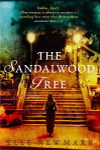Elle Newmark – The Sandalwood Tree
Posted 8th April 2011
Category: Reviews Genres: 2010s, Domestic, Historical, LGBT, Political, Romance, Social
1 Comment

History is always changing because we are always finding out about new aspects of it.
Publisher: Atria Books (Simon & Schuster)
Pages: 357
Type: Fiction
Age: Adult
ISBN: 978-1-4165-9059-0
First Published: 17th February 2011
Date Reviewed: 31st March 2011
Rating: 5/5
It’s 1947 and American Evie has come to India with her husband and son while her husband documents the fall of British rule. Martin has changed since the Second World War and though Evie hoped the move to India would re-ignite their marriage it seems unlikely to happen. In heartache she turns to cleaning in order to gain control where it was lost and it’s here that she discovers a loose brick in their hundred-year-old house. Hidden inside the gap is a bunch of letters dated 1850’s – suddenly Evie has a purpose of her own.
Although I’ve read a lot of books recently that I enjoyed perhaps even more than The Sandalwood Tree, on no occasion have I been able to read without checking every now and then on my progress – until this book. I finished it without really noticing. The book is full to bursting with delightful contents.
Admittedly it probably helps that I’m interested in India and its many cultures and can speak a bit of Hindi (the book contains a smattering of the language) but I’d hope that the immense richness of detail is undeniable to anyone. Newmark may to a certain point exoticise the country, this makes sense considering the time periods she writes of, but it’s the overall research and the way she describes the places that make the book what it is. The colours of the cover match the story perfectly.
The Sandalwood Tree flips back and forth between 1947 – the time of Partition – and the 1850s, when relations between the British and Indians were understandably bad. It details the events that happened during those times (although the book ends before Partition happens so it’s the lead-up that is examined) but the emphasis is on the lives of the characters and the particular social issues relevant to them. Evie, as an American, finds herself more open-minded than the Brits in her circle and so you get to see a few different points of view. Her own story becomes very much effected by the letters she reads, leading her to find India more homely and enabling her to really consider the impact her husband’s years in service have had on their marriage. Her son, Billy, is a joy in himself, being rather bold and knowledgeable and, being five years old in 1940s India, his own development as a character is particularly interesting.
The letters Evie finds become a second plot in their own right. Even though it is Evie who reads the letters and finds out about the women in them, so much time is given to the letters themselves that it’s easy to forget that. This sort of story has been done before, but because of Newmark’s writing style and the connection she makes between the women and Evie, it is fascinating. I should probably say that Evie’s story is told in the first-person, the 1850’s via the letters and a diary. The various social issues covered due to the two characters love interests make the book very compelling.
I would observe and understand India without India actually touching me.
One of the most interesting elements of the book is the way the domestic squeezes its way into the social, and vice versa.
A second conflict of cultures happens as the back-story to Martin’s plight in the form of the Germans and anyone against them. Consider the following:
He said it bothered him that German sounded so much like the Yiddish of his grandparents; then he shook his head as if he was trying to understand something.
Newmark’s point is poignant, that there was no real difference between Jews and Germans other than religions. Martin’s experiences, when put against the issues surrounding partition add another layer of thought to the book, show in both cases how society can change so quickly when a line is drawn in the middle.
The only thing I took issue with was the phrase “buttoning the curtains down” within the letters written in the 1850’s by British people. I have come to recognise the phrase “button down” through reading American literature, but it’s not something we say in Britain and thus is out of place in an old English letter. But I feel I have demonstrated my feelings overall: this book is pretty near perfect.
The Sandalwood Tree brings many different generations, cultures, religions, nationalities, domestic situations and opinions to its relatively modest 357 pages, and deals with all effectively. Whether the research is spot-on I can only say as much as I know personally, but it definitely comes across as a triumph all round.
The answer to would I recommend this book is a resounding “yes”.
I received this book for review from the author thanks to Pump Up Your Book.
Related Books
None yet
1 Comment
Comments closed























April 11, 2011, 4:37 pm
I’m really glad you enjoyed this one. You’re right, the cover matches beautifully. And come to think of it, I never really felt the need to check my progress, either. Though I did get tired of all the saris being described as __(fruit)__-colored.
Charlie: Now you say it, I’m remembering all the sari colours she mentioned. I liked it, although it was a little odd because it’s such a different way of doing it, I think the first time I had to stop and consider what the fruit looked like!